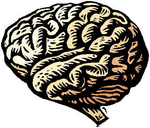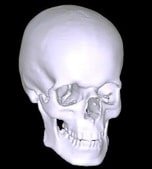TRAUMATIC BRAIN INJURY (TBI): JUST THE FACTS
 By Carol Ware Duff MSN, BA, RN
By Carol Ware Duff MSN, BA, RN
Injuries to the brain may be more common than you know. With exposure to blasts, the military is a prime target for such an injury.
Traumatic brain injury (TBI) is an acquired injury to the brain by an abrupt trauma. In a TBI the head area has suffered an assault of some type whether it was a blast, motorcycle or car accident, assault, or even a fall. The brain moved within the hard bone of the skull. This trauma can be from the head being struck by an object at one or more locations, an explosion, or when an object pierces the skull and enters the brain.
Perhaps the injured person never lost consciousness or had been unconscious for a few seconds to minutes after the brain assault. The shaking of the brain back and forth within the skull can cause a coup (same side as blow) or contrecoup injury which is damage to the brain on the opposite side of the blow as the brain is forced against the other side of the skull. The brain bounces against the skull and the nerve cells and connections between these cells are damaged or destroyed. Car accidents after sudden stops or when a baby is shaken hard enough to cause his or her brain to move within the skull are two types of contrecoup injury.
Blood vessels within the brain can be damaged by sudden and violent jarring of the brain and create opportunities for bleeding. Bleeding causes lack of oxygen to brain tissue and/ or increased pressure due to leakage of blood into the skull.
.
According to the National Institute of Neurological Disorders and Stroke (NINDS), TBIs cost the U.S. more than $56 billion per year and more than five million Americans who are alive today have had a TBI that resulted in a need for assistance to perform their daily activities because of disabilities in communication, behavior, and cognition,( thinking, reasoning, problem solving, memory, and information processing). Others go on to develop long-term medical complications such as epilepsy.
In the U.S. alone, about 1.4 million people experience a TBI, of these 50,000 die, about one million are treated for TBI in emergency rooms, and about 230,000 are hospitalized for TBI and survive. The entire family is affected when a loved one suffers a TBI and any knowledge of what causes TBIs and what to expect as normal behavior from a person who has a TBI can help the family cope and assist their loved one through the healing process.
TBI is a complex disease with many causes that assault the brain ranging from swelling (edema), axonal injury (resulting from lack of oxygen to the injured part of the brain), main contusions, and hematomas ( areas of bleeding). TBIs can range from shaken baby syndrome (where an infant is shaken by a caregiver who is frustrated with the baby crying) to being involved in explosions during military situations as well as during accidental explosions. Any trauma to the brain is a dreadful thing and can lead to life-time medical consequences. Trauma to the brain is exactly the same as trauma to visible parts of the body. Cells are destroyed or injured.
Millions of head injuries occur every year throughout the world with approximately five million attributed to traffic accidents. Some people die from these accidents and others live, often with the consequences of TBI.
Symptoms after TBI can range from mild to severe and all stages in between. Some symptoms may appear immediately after the trauma or may appear much later. Symptoms:
- There can be headache that goes away or remains.
- Not feeling like oneself.
- Feeling sad, anxious or listless.
- Blurred vision.
- Ringing in the ears.
- Confusion.
- Feeling dizzy.
- Feeling very tired or lethargic.
- Mood or behavioral changes.
- More sensitive to sounds, light, and distractions.
- Trouble with paying attention and memory.
- Inability to make decisions or to solve problems.
- Difficulty being able to concentrate, of ever thinking.
- Changes in sexual behavior or interest in sex.
- Inability to control behavior.
- Impulsiveness.
- Feeling easily overwhelmed.
- Changes in sleeping patterns with needing more or less sleep.
- Periods of nausea and or vomiting.
- Changes in taste.
- Slurred speech.
- Dilation of one or both pupils of the eyes (black part of eyes gets bigger).
- Loss of coordination with or without weakness or numbness in arms or legs.
- Agitation and restlessness.
On the severe end there may be convulsions, seizures, or the inability to wake up. Sometimes the person with the TBI may not be aware of changes he or she are experiencing, but those nearby, who know him or her, will recognize changes.
As with anyone who has suffered trauma to the head, those with signs of moderate to severe TBI should get medical attention pronto. Primary concerns are that proper oxygen supply to the brain is present, as well as maintaining adequate blood flow and controlling blood pressure and pressure within the brain. There is often nothing that can be done to reverse initial brain damage caused by the trauma, but care can be taken to prevent further damage or injury. TBIs are major causes of both military and civilian death and disability in America particularly in males in both the young group and the elderly.
The incidence of TBIs in the military is vast due to various jobs such as parachuting and others risks for head traumas. Youth and being male can create a scenario that can produce risk taking. Being in war and combat situations place veterans in areas where they can be assaulted with bombs and explosives. Bullets, fragments, falls, assaults and being involved in a fight can also produce a TBI. A veteran who has suffered a TBI may minimize being subjected to TBI and not report signs or symptoms that may arise after head trauma.
Congress created the Defense and Veterans Brain Injury Center in 1992, during the Persian Gulf War to organize specific TBI care, for research, and to provide education about TBIs across the VA and military healthcare systems. Countless soldiers have been subjected to traumatic injuries due to blast exposure. In recent years these explosions are due largely to improvised explosive devices (IED). Exposure to land mines, RPGs, and grenades create blast situations. As with the current conflicts, soldiers in previous wars and conflicts (WWII, Korean War, Vietnam War, etc) have also been exposed to explosions and consequently have been subjected to the possibility of a TBI even if they were not diagnosed as such. If you have not been in these most recent conflicts, but have been in situations where you were exposed to blasts you should make sure your healthcare provider has this knowledge.
The advances in body armor technology and trauma care have been factors in more veterans surviving previously fatal injuries, but a helmet on the head is not enough to stop TBIs. By 2003, as soldiers were coming back to medical treatment in the U.S. from the Iraq, it was noted that mild to moderate TBIs were being overlooked because of the life-threatening nature of other injuries such as amputations and burns. Walter Reed Medical Center started to screen all veterans wounded in the war for exposure to falls, blasts, auto accidents, or gun shot wounds to face or neck and found a large incidence of TBIs, often accompanying other life threatening assaults to other parts of the body. Currently the apparent inability to create vehicles that are impervious to blasts and explosions contribute to TBIs. Many military injuries occur when vehicles are blow up while driving along roads where explosive devices have been hidden.
In April of 2007 the VA Central Office issued a directive beginning a compulsory procedure for screening of symptomatic TBI among all OEF/OIF veterans. These screening tools are:
-
Has there been an change in consciousness after a traumatic event?
-
A history of injury event that could cause TBI.
-
New or worsening symptoms after a traumatic event.
-
Continuation of the symptoms into the present.
-
Yes answers to these four topics would be a positive for TBI.
For the veteran to receive the best possible care there must be a team approach to diagnosis and to rehabilitate someone who has received a TBI. The Polytrauma System of care as been developed to meet the many needs of those with TBI. For acute inpatient medical and rehabilitation care there are five Polytrauma Rehabilitation Centers (PRCs), and twenty-one regional Polytrauma Network Sites (PNS) to manage post acute issues such as specialty rehabilitation evaluation and care coordination, outpatient and inpatient rehab, day programs, and programs to help with transition. Polytrauma Support Clinic Teams (130) answer to managing patients who have stable treatment plans, provide regular follow-up visits, and react to new problems. Each PRC is developing or expanding the transitional reentry program (PTRP).
In exploring the aspect of war, certain scientific goals have been proposed to address the issue of TBI in veterans. Two of these goals are to explore the immediate and long-term neurological (nervous system) effects of exposure to blasts and to define the potential clinical indicators of blast exposure such as imagining (MRIs), biochemical markers, and neurobehavioral assessments.
The four types of blast injuries are Primary– overpressure of “blast wave,” secondary from flying debris, tertiary – being thrown into stationary objects or structural collapse, and quaternary which are injuries due to other causes such as thermal, burns, and toxic inhalation. With blast related injuries the soldier has had an acceleration of the head, received the transmission of pressure waved across skull, spread of waves across the thorax (chest), blast waves through chest by movement of blood vessels, and oscillation (vibrations) of vessels are transported to the brain which damages neurons ( nerve cells).
The VA definition for TBI is that there is a diagnosis of a traumatic induced disruption to the brain after at least one of the following: loss of consciousness, any loss of memory either before or directly after event, an alteration in mental state such as feeling confused, dazed, and a neurological deficit or deficits such as double vision, lack of coordination, or speech difficulties. Diagnosis of mild TBI requires a mechanism of injury and credible blow to face and or head.
At the HSR & D 2009 meeting information was shared on PTSD and other Psychiatric Comorbidities (accompaniments) in OEF/OIF ( Operation Enduring Freedom/Operation Iraqi Freedom) VA users with TBI. The presenters were K. Carlson, N. Sayer, D. Nelson, S. Nugent, and R. Orazem who are all associtated with the Center of Chronic Disease Outcomes Research. Since the veterans from these two operations were at risk for post traumatic stress disorder (PTSD) and TBI, it was purposed necessary to examine the co-occurrence of PTSD and TBI in those veterans who were serviced in an upper Midwest VISN between April 2007 and August 2008.
The results of 11,990 veterans screened for TBI, 2,033 (17%) were positive for TBI and of these 744 (37%) were given a diagnosis of TBI. Due to the make up of the military, the majority of the patients were male (95%), Caucasian (77%), and service connected (76%). The average age was 30.4 years and psychiatric comorbidites (PTSD 65%, substance use abuse (26%), major depressive disorders (19%) were noted in 85%) of the patients with TBI. More than half had two or more psychiatric diagnoses. What does this mean? Veterans of OEF/OIF who have been diagnosed with a TBI may commonly have a psychiatric disorder, particularly PTSD. Not at all surprising when one considers that to be involved in a blast could be the precursor to PTSD. An important factor for consideration in ongoing treatment for post TBI is that a veteran with PTSD or other psychiatric disorders might be less willing to come back for further treatments for his or her TBI.
Recovery tools that might help someone after a TBI are:
-
Increasing activities slowly.
-
Getting plenty of rest/sleep.
-
Carrying a notebook around to write down things to remember.
-
Do only one thing at a time if you are distracted easily.
-
Turn off the radio or TV to concentrate.
-
Check with someone you can trust when you have decisions to make.
-
Establish a daily routine.
-
Avoid activities that could lead to another TBI.
-
Caffeine and energy drugs may enhance negative symptoms.
-
Alcohol will not help.
-
Avoid lasting use of over the counter (OTC) sleeping aides.
-
Do not take products with pseuoephedrine (cough ,allergy and cold medicines).
-
If this is not the first time for the TBI it may take longer to feel better.
TBI will remain a possible injury, especially for the military who are exposed to blasts and explosions. While this is not a new injury, TBI is being seen as a typical injury associated with OEF/OIF and will surely continue and accompany troops into Afghanistan with the continued use of explosives.
References
Abrams, Gary, 2009. Clinical aspects of traumatic brain injury (TBI) retrieved on October 21, 2009 from http://www.warrelatedillness.va.gov/paloalto/conferences/january-2009/handouts/abrams-handout.pdf
HSR&D National Meeting, 2009. PTSD and other comorbidities in OEF/OIF Va users with TBI. U.S. department of veterans affairs. Retrieved on October 21, 2009 from http://www.hsrd.research.va.gov/meetings/2009/print_abstract.cfm?RecordID=376
Lew, H., Cifu, D, B. Sigford, S. Scott, N. Sayer, & M. Jaffee, 2007. Team approach to diagnosis and management of traumatic brain injuries and its comorbidities. Journal of Rehabilitation Research and Development, 44, (7), 7-11.
Medline Plus, 2009. Traumatic brain injury. Retrieved October 21, 2009 from http://www.nlm.nih.gov/medlineplus/traumaticbraininjury.html
National Institute of Neruological Disorders and Stroke, 2009. Clinical trials in head injury, retrieved on October 21, 2009 from
http://www.ninds.nih.gov/news_and_events/proceedings/headinjurywkshp.htm
National Institue of Neurological Disorders and Stroke, 2009. Neurological effects of blast retrieved October 21, 2009 from http://www.ninds.nih.gov/news_and_events/proceedings/Neurological_Effects_of_Blast_Injury_Workshop.htm National
National Institue of Neurological Disorders and Stroke, 2009. Traumatic brain injury: Hope through research. Retrieved on October 21, 2009 from http://www.ninds.nih.gov/disorders/tbi/detail_tbi.htm#136243218
National Institute of Neurological Disorders and Stroke, 2009). Traumatic brain injury information page. Retrieved October 21, 2009 from http://www.ninds.nih.gov/disorders/tbi/tbi.htm#What_is
Taber, K. & Hurley, R. Quick guide to traumatic brain injury. Retrieved on October 23, 2009 from http://www.mirecc.va.gov/docs/visn6/TBI-article.pdf
Taber, K & Hurley, R., 2007. Traumatic axonal injury: Atlas of major pathways. The Journal of Neurophychiatry and Clinical Neurosciences (19) 2.
Carol Duff graduated from Nursing School at Riverside White Cross in Columbus, Ohio. 
She has a BA from Bowling Green University in History and Literature and a Masters of Science in Nursing as a Nurse Educator from the University of Toledo School of Nursing.
She has traveled extensively and has written on military history, veterans health issues and related subjects. She is the mother of several children and 10 cats and 1 guinea pig.
She can be reached via email at: [email protected]

Carol graduated from Riverside White Cross School of Nursing in Columbus, Ohio and received her diploma as a registered nurse. She attended Bowling Green State University where she received a Bachelor of Arts Degree in History and Literature. She attended the University of Toledo, College of Nursing, and received a Master’s of Nursing Science Degree as an Educator.
She has traveled extensively, is a photographer, and writes on medical issues. Carol has three children RJ, Katherine, and Stephen – one daughter-in-law; Katie – two granddaughters; Isabella Marianna and Zoe Olivia – and one grandson, Alexander Paul. She also shares her life with her husband Gordon Duff, many cats, and two rescues.
ATTENTION READERS
We See The World From All Sides and Want YOU To Be Fully InformedIn fact, intentional disinformation is a disgraceful scourge in media today. So to assuage any possible errant incorrect information posted herein, we strongly encourage you to seek corroboration from other non-VT sources before forming an educated opinion.
About VT - Policies & Disclosures - Comment Policy




